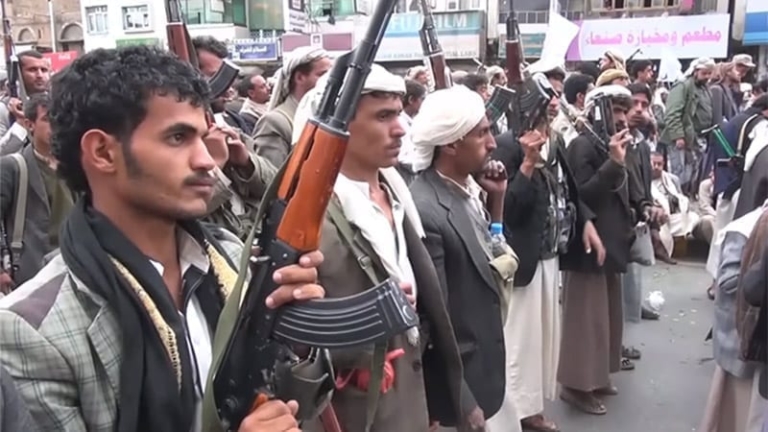
The Saudi Arabia-led intervention in Yemen marks the completion of its third year this month and without an end in sight. Moreover, domestic Yemeni actors seem to be ever farther from agreeing on a comprehensive resolution to the country’s civil war. While the international community continues to wring its hands as the crisis continues, tens of thousands have died or have been injured, hundreds of thousands have contracted serious diseases as a result of the human-made emergency, and millions find it hard to secure their daily bread and shelter. As Saudi-led coalition aircraft pound the country from the air, Yemen has become a battlefield for Houthi insurgents and their allies challenging legitimate authority, tribal elements disputing with each other or asserting dominance over ancestral domains, al-Qaeda in the Arabian Peninsula (AQAP) and affiliated militiamen fighting their battles, and secessionists dreaming of recreating the pre-1990 state in the south. Each has regional supporters either vying against each other or angling to have long-term influence and advantage along one of the most strategic expanses of the Middle East.
During the last three years alone, over 9,200 persons have been killed and close to 53,000 injured.
Indeed, the situation in Yemen illustrates the inability of its domestic actors to arrive at acceptable compromises and the failure of regional and international players to come to terms with each other’s interests and preferences while preserving Yemen’s sovereignty and unity. This animated the February 27, 2017 poignant address to the United Nations Security Council by the former UN Special Envoy for Yemen Ismail Ould Cheikh Ahmed, whose term has just expired. He decried the parties’ “destructive pattern of zero-sum politics” and decision-makers who “perceive concessions as weakness and dissent as a threat” while “disregarding the daily suffering of Yemenis generated by this conflict.” It is hoped that the new envoy, Martin Griffiths––appointed mid-February by UN Secretary General António Guterres––will be able to navigate the jungle of internal and external challenges in Yemen, although the current stalemate there promises to cause and add even more harm to the country’s history of autocratic rule, instability, poverty, and neglect.
Regional Intervention Exacerbates Conditions
It would be inaccurate to blame outside intervention in the Yemeni civil war solely for the calamitous political, economic, and social situation in the country, for its troubles are first and foremost a product of decades of oppression, corruption, and bad governance in Sanaa. Nonetheless, it is necessary to point out that this intervention has exacerbated human suffering and underscored the differences between Yemen’s elites, warring factions, and tribal formations. Worst has been the toll on human life and conditions since March 2015, when Operation Decisive Storm was launched by Saudi Arabia and its allies, supposedly to restore the legitimate government of President Abdrabbuh Mansour Hadi to the capital.
The United Nations has documented this humanitarian crisis. During the last three years, over 9,200 persons have been killed and close to 53,000 injured. Seventy-five percent of the population, about 22.2 million people, need humanitarian assistance, 11.3 million of whom require immediate help. Close to 18 million do not know how they will secure their livelihood while 8.4 million are at risk of starvation. Malnutrition threatens 400,000 children under five years of age. As only half of the country’s 3,500 medical facilities still function, 16.4 million people now lack healthcare. There are 1 million suspected cases of cholera, which, since April 2017, has killed 2,300 individuals. Finally, 3 million Yemenis have been made homeless at different times, while 2 million of them remain displaced today.
The Saudi-led coalition’s air raids have struck all economic activities, from farming to fishing to food storage facilities and marketplaces.
In his farewell address to the United Nations, the former envoy to Yemen Ould Cheikh Ahmed highlighted the escalation in military activities in a number of Yemeni provinces and along the Yemeni-Saudi border and warned against the recruitment of child soldiers by all parties, with the Houthis being the worst violators in this regard. He also warned against the worsening economic situation, pointing out that since 2015 the Yemeni economy has shrunk by almost 40 percent. In 2017, the Yemeni riyal lost half its value, devaluing salaries and diminishing the purchasing power of people in the public and private sectors. A recent report laid part of the blame on the United Arab Emirates, Saudi Arabia’s premier military ally in Yemen, for preventing the entry of funds sent to the Yemeni Central Bank, which was moved to Aden by President Hadi in 2016 presumably to escape Houthi looting of the state’s financial assets.
The Saudi-led blockade on the country’s air and sea ports, as well as persistent air raids, have prevented the delivery of needed food, fuel, and medicine. Iona Craig, a reporter and frequent visitor to Yemen, writes that the Saudi-led coalition’s air raids have struck all economic activities, from farming to fishing to food storage facilities and marketplaces. In a country where 80 percent of imports arrive by sea, blockading ports is a serious violation of international law. In addition to air raids, as Peter Salisbury of Chatham House reports, Yemenis are subjected to the unscrupulous machinations of businessmen and militiamen who are more interested in perpetuating a war economy that enriches them than in helping to end the grinding civil war. Such profiteering cannot be seen except as a serious threat to the country’s population and future; and the regional military intervention is unlikely to change this situation for the better.
Impact of Regional Machinations
Just as serious is the stalemate on the battlefield between troops loyal to the legitimate government of Mansour Hadi and those to the Houthis and their allies, while coalition forces continue to fail to check the Houthis. As pro-Hadi government troops continue to face the Houthis in central Yemen, the latter have tightened their grip on Sanaa and other cities. The Houthis’ killing of the former president, Ali Abdullah Saleh, last November has eliminated a credible rival to their supremacy and destabilized Saleh’s tribal alliances and political constituency. What is left of his base is divided between his son and former head of the Republican Guard, General Ahmed Saleh, military commanders who chose to defect to President Hadi (where they could in the country), opportunists who sided with the Houthis, and those who could not go anywhere for fear of Houthi reprisal.
Saudi and Emirati machinations in Yemen are unlikely to be challenged by the United States.
But while Ali Abdullah Saleh’s assassination shuffled Yemen’s domestic deck of cards and probably sidelined his General People’s Congress in the Yemeni political equation, it may have prevented potential unwelcome developments in the future. The assassination came after his fateful and last political maneuver in December, when he struck a deal with Saudi Arabia to break away from the Houthis and deprive them of his political cover. That move, and Riyadh’s acceptance of his potential rehabilitation, was fraught from the beginning for at least three reasons. First, Saudi Arabia was the main architect of the GCC Initiative of 2012 that facilitated Saleh’s departure and Hadi’s ascendance to the presidency, following Yemen’s Arab Spring protests of 2011. Second, Saudi Arabia intervened militarily in March 2015 against the Houthi-Saleh alliance specifically to restore Hadi’s legitimate and internationally recognized government to Sanaa. Third, the kingdom is supposedly Hadi’s current main benefactor and hosts him in Riyadh until he can return to power. However, there are reports that he is unable to leave the Saudi capital and return to Aden, making his fate as president uncertain. In other words, had Saleh escaped assassination, these dynamics would have only made things more complicated for Saudi plans in Yemen and probably created unseen and potentially unwarranted conditions.
Nonetheless, Saleh’s departure from the scene does not end Saudi Arabia’s problems regarding its policy toward Yemen. While the Houthis continue to be a threat to the kingdom’s security on its southern border and represent a major challenge to its aerial campaign, it is the UAE’s role in the country that poses a significant challenge to Yemen’s unity and sovereignty—which are presumably important goals for Riyadh as well as for the UAE, which accepted UN Security Council Resolution 2216 of 2015 that asserted these principles. Since its troops helped to liberate Aden from Houthi control, the UAE has nurtured a southern secessionist movement that it views as serving its strategic interests along the Red Sea-Gulf of Aden-Arabian Sea stretch. It has supported the creation of the Southern Transitional Council and helped arm its military forces, which last January took over strategic positions held by troops loyal to President Hadi in Aden.
The UAE has also been on very unfriendly terms with President Hadi, who accused Abu Dhabi crown prince and strongman, Mohammed bin Zayed, of behaving like an occupier. This not only sours official Yemen-UAE relations but suggests a serious problem in Saudi-Emirati coordination; that is, however, if Saudi Crown Prince Mohammed bin Salman remains steadfast on Saudi support to Hadi—a prospect that no one can ascertain given the crown prince’s risk-taking and erratic behavior. But whatever happens to Yemen-UAE or Saudi Arabia-UAE relations, continuing the present course of events is likely to lead to more north-south fissures in Yemen, a weaker hand in fighting the Houthis and challenging Iran’s support to them, and a less vigorous campaign to end the presence of terrorist bases on Saudi Arabia’s border with Yemen.
One only hopes that Riyadh and Abu Dhabi will find the political will and necessary means to do what they can to alleviate Yemen’s human tragedy sooner rather than later.
Finally, Saudi and Emirati machinations in Yemen are unlikely to be challenged by the United States, thus far the surest supporter of their intervention in the country. In fact, US support for coalition operations or American raids on AQAP and Islamic State bases in the country are not expected to cease, despite the humanitarian costs. And with Washington’s tumultuous political atmosphere surrounding President Trump’s haphazard approach to many Middle Eastern files, including Yemen’s, Riyadh and Abu Dhabi will continue to count on a carte blanche from the administration to do what they deem fits the situation. This makes Yemen primarily their responsibility—with what that may entail of continued instability, absence of compromise, potential partition, and, most calamitous of all, an even worse humanitarian crisis.
There should be no doubt that Saudi Arabia and the UAE, as the two major regional players in the Yemen crisis, are responsible for devising a comprehensive plan for a Yemeni peace that prevents the occurrence of these four dangerous developments. An unstable Yemen is detrimental to everyone’s interests in the region, most notably Saudi Arabia’s and the UAE’s. The continued absence of compromise is harmful to both domestic Yemeni actors and regional players. Saudi Arabia and the UAE should also know that a partitioned Yemen will be a base for more instability on their borders and on the shores of the Red and the Arabian Seas, whose routes their precious energy commodities traverse. As for the human tragedy that has unfolded in the Arab world’s poorest country, one only hopes that Riyadh and Abu Dhabi will find the political will and necessary means to do what they can to alleviate it sooner rather than later.

